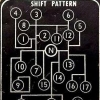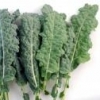Correct. As the lactic acid gets you only like 400m, really fast

David Sinclair strikes again
#91
Posted 23 December 2013 - 11:06 PM
Correct. As the lactic acid gets you only like 400m, really fast
#92
Posted 23 December 2013 - 11:13 PM
***
What did Sinclair's mice actually eat, do we know? Also, do we really know how much they were able to move about? Anyhow, it is a fact that each of calorie restriction, carb restriction and exercise (this one subject to a U curve) increase SIRT1 expression and longevity. Conversely, each of excess calories, high carbs and a sedentary lifestyles shorten lifespans. NAD+ must correlate with these findings, if its impact indeed are that profound. Causation and correlation can be a real b***h to figure out.
http://www.google.co...MIEbKiO_45LX63A
Edited by Ukko, 23 December 2013 - 11:14 PM.
#93
Posted 23 December 2013 - 11:26 PM
"Glutamine amide nitrogen is used in the synthesis of the vitamins NAD and NADP, purine nucleotides, CTP from UTP and asparagine. Nitrogen initially stored in glutamine can also be used to produce carbamyl phosphate for the synthesis of pyrimidines."
http://www.jbc.org/c.../13/10914.short
http://www.ncbi.nlm..../pubmed/9625578
http://en.wikipedia....ine-hydrolysing)
Edited by Ukko, 24 December 2013 - 12:00 AM.
#94
Posted 24 December 2013 - 03:04 AM
aberration in mitochondrial complex I NADH dehydrogenase activity can profoundly enhance the aggressiveness of human breast cancer cells
And complex I NADH dehydrogenase is...
http://en.wikipedia....se_(ubiquinone)Complex I (EC1.6.5.3) (also referred to as NADH:ubiquinone oxidoreductase or, especially in the context of the human protein, NADH dehydrogenase (ubiquinone)) is an enzyme of the respiratory chains of myriad organisms from bacteria to humans. It catalyzes the transfer of electrons from NADH to coenzyme Q10 (CoQ10) and, in eukaryotes, it is located in the innermitochondrial membrane. It is one of the "entry enzymes" of oxidative phosphorylation in the mitochondria.[1]
I wonder if this can help explain the effects of C60/EVOO due to possible positive effects by C60 on the electron transfer chain in the inner mitochondrial membrane? We may have already solved this NAD+ issue with C60/EVOO.....
I can't help but wonder if the NAD+ issue is at least a partial explanation for the anecdotal experiences (and possible benefit) of C60/EVOO with respect to what we know to date or have hypothesized about C60/EVOO:
1) C60/EVOO accumulates in the mitochondria....where NAD+ is formed in the interaction of the Krebs Cycle via Electron Transport Chain
2) C60 is hypothesized to act as both an electron acceptor and donator, able to hold or store numerous electrons on it's cage
3) As such, C60 can buffer electrons in the ETC and prevent disruptions in the ETC that can negatively disrupt the NAD/NADH ratio
When NADH is reduced to NAD, the electron transport chain accepts the electrons from the molecules. As the electrons are transferred to each carrier within the electron transport chain, free energy is released and is used to form ATP. Oxygen is the final acceptor of electrons in the electron transport chain. Without oxygen, the electron transport chain becomes jammed with electrons. Consequently, NAD cannot be produced.
#95
Posted 24 December 2013 - 04:10 AM
Op-Ed: First ever aging reversal — But will the public ever have access?
http://www.digitaljo.../article/364493
#96
Posted 24 December 2013 - 04:52 AM
 NAD-A.jpg 55.31KB
129 downloads
NAD-A.jpg 55.31KB
129 downloadsNAD+ concentrations decline with age in males (click graph to enlarge)
 NAD-B.jpg 45.64KB
123 downloads
NAD-B.jpg 45.64KB
123 downloadsNAD+ concentrations decline with age in females (click graph to enlarge)
Source: Massudi H, Grant R, Braidy N, Guest J, Farnsworth B, et al. (2012) Age-Associated Changes In Oxidative Stress and NAD+ Metabolism In Human Tissue.
Edited by trance, 24 December 2013 - 04:53 AM.
#97
Posted 24 December 2013 - 04:57 AM
#98
Posted 24 December 2013 - 05:43 AM
Combining the two seems like a attractive strategy: NAD+ precursor + AMPK inducer synergy, with the advantage they require a common conjugate for excretion, but glycine depletion definitely has some negatives, in reducing pyruvate levels (and fat burning) and uric acid (a glycine metabolite and the primary plasma antioxidant).
I'm thinking about adding equimolar amounts of glycine should I ramp up a NA+ASA stack, on the other hand, with continued use glycine synthesis (glucose→3-phosphoglycerate→serine→glycine) would be expected to upregulate to compensate, and NA/ASA excretion might just be a slight calorie drain - not such a bad thing.
My major concern is hypouricemia, which I'm already at risk for due to a low purine vegan diet. Uric acid is usually thought of in terms of gout, but if high uric acid is protective against Parkinson's, is clearly possible very low uric acid could increase risk of PD and other oxidative stress disorders.
I suppose the best option would be to just monitor blood uric acid to ensure it doesn't fall too low, and add inosine and glycine as necessary.
#99
Posted 24 December 2013 - 07:35 AM
In the meantime, I tried some black rice. It's easy to prepare, delicious enough to eat with nothing but salt, and relatively inexpensive - I think I'll eat it regularly going forward. I certainly don't expect any miracles out of it, but this research isn't the only reason to increase anthocyanin consumption. The other suggestions in this thread are appreciated as well - thanks!
#100
Posted 24 December 2013 - 07:37 AM
#101
Posted 24 December 2013 - 05:53 PM
I think Darryl mentioned sublingual NR and NAD. Anybody try this? Do they readily absorb sublingually?
Sublingual NADH totally absorbs sublingually. Even more stimulating than coffee for me. Gets pricey though. Also have NAD+ with enteric coating still around. Not for sublingual use though.
Edited by Ukko, 24 December 2013 - 06:01 PM.
#102
Posted 26 December 2013 - 07:08 PM
http://www.delphion....0A2&hid=6#GDESC
http://www.delphion....pn=US2C022013A1
Can we learn something new from these references?
#103
Posted 26 December 2013 - 07:38 PM
•provision of NAD+ precursors (nicotinic acid, nicotinamide riboside, injections of nicotinamide mononucleotide)
•AMPK induction to increase levels of NAD+ synthesis (exercise, fasting, aspirin, metformin, berberine, etc)
•CD38 inhibition (flavonoids especially luteolinidin, cyanidin-3-O-β-glucoside, and luteolin appear promising, see post 58)
•poly (ADP-ribose) polymerase-1 (PARP-1) inhibition.
The most current discussion of accessable PARP-1 inhibitors seems to be: Banasik, Marek, Todd Stedeford, and Robert P. Strosznajder. "Natural inhibitors of poly (ADP-ribose) polymerase-1." Molecular neurobiology 46.1 (2012): 55-63.
Taurine appears to reduce PARP-1 expression, while PARP-1 inhibitors include caffeine metabolites, various flavonoids (especially naringin and (+)-catechin), theophyline (from cocoa), vitamin D, and polyunsaturated fatty acids.
Sun, Ming, et al. "Anti-inflammatory mechanism of taurine against ischemic stroke is related to down-regulation of PARP and NF-κB." Amino Acids 42.5 (2012): 1735-1747.
Rats received 2 h ischemia by intraluminal filament and were then reperfused. Taurine (50 mg/kg) was administered intravenously 1 h after ischemia. Treatment with taurine markedly reduced neurological deficits, lessened brain swelling, attenuated cell death, and decreased the infarct volume 72 h after ischemia. Our data showed the up-regulation of PARP and NF-κB p65 in cytosolic fractions in the core and nuclear fractions in the penumbra and core, and the increases in the nuclear poly (ADP-ribose) levels and the decreases in the intracellular NAD+ levels in the penumbra and core at 22 h of reperfusion; these changes were reversed by taurine. Moreover, taurine significantly reduced the levels of tumor necrosis factor-α, interleukin-1β, inducible nitric oxide synthase, and intracellular adhesion molecule-1, lessened the activities of myeloperoxidase and attenuated the infiltration of neutrophils in the penumbra and core at 22 h of reperfusion.
Geraets, Liesbeth, et al. "Caffeine metabolites are inhibitors of the nuclear enzyme poly (ADP-ribose) polymerase-1 at physiological concentrations." Biochemical pharmacology 72.7 (2006): 902-910.
In this study the PARP-1 inhibiting capacity of caffeine and several metabolites as well as other (methyl)xanthines was tested using an ELISA-assay with purified human PARP-1. Caffeine itself showed only weak PARP-1 inhibiting activity, whereas the caffeine metabolites 1,7-dimethylxanthine, 3-methylxanthine and 1-methylxanthine, as well as theobromine and theophylline showed significant PARP-1 inhibiting activity. Further evaluation of these compounds in H2O2-treated A549 lung epithelial and RF24 vascular endothelial cells revealed that the decrease in NAD+-levels as well as the formation of the poly(ADP-ribose)polymer was significantly prevented by the major caffeine metabolite 1,7-dimethylxanthine. Furthermore, H2O2-induced necrosis could be prevented by a high dose of 1,7-dimethylxanthine.
Geraets, Liesbeth, et al. "Dietary flavones and flavonoles are inhibitors of poly (ADP-ribose) polymerase-1 in pulmonary epithelial cells." The Journal of nutrition 137.10 (2007): 2190-2195.
In this study, the in vitro PARP-1-inhibiting effect of various flavonoids was investigated. The flavonoids myricetin, tricetin, gossypetin, delphinidin, quercetin, and fisetin were identified as significant inhibitors of the purified enzyme. Further evaluation of these compounds in N-methyl-N′-nitro-N-nitrosoguanidine-treated human pulmonary epithelial cells showed that the formation of the poly(ADP-ribose) polymers, as well as the decreased NAD+ levels, was reduced by quercetin, fisetin, and tricetin. Finally, IL-8 production of LPS-stimulated human pulmonary epithelial cells could be significantly reduced by these flavonoids.
Moonen, Harald JJ, et al. "Theophylline prevents NAD+ depletion via PARP-1 inhibition in human pulmonary epithelial cells." Biochemical and biophysical research communications 338.4 (2005): 1805-1810.
PARP-1 activation by hydrogen peroxide decreased intracellular NAD+ levels in human pulmonary epithelial cells, which was found to be prevented in a dose-dependent manner by theophylline, a widely used compound in the treatment of COPD. This enzyme inhibition by theophylline was confirmed in an ELISA using purified human PARP-1 and was found to be competitive by nature.
Mabley, Jon G., et al. "Inhibition of poly (adenosine diphosphate-ribose) polymerase by the active form of vitamin D." International journal of molecular medicine 19.6 (2007): 947.
The active metabolite of vitamin D, 1α,25-dihydroxy-vitamin D3, is a PARP inhibitor. UV irradiation-mediated PARP activation in human keratinocytes can be inhibited by treatment with vitamin D, 7-dehydrocholesterol or 1α,25-dihydroxyvitamin D3. Inhibition of cytochrome P450 reversed the PARP inhibitory action of vitamin D and 7-dehydrocholesterol, indicating that conversion to 1α,25-dihydroxyvitamin D3 mediates their PARP inhibitory action. Vitamin D may protect keratinocytes against over-activation of PARP resulting from exposure to sunlight. PARP inhibition may contribute to the pharmacological and anti-inflammatory effects of vitamin D.
Banasik, Marek, Hajime Komura, and Kunihiro Ueda. "Inhibition of poly (ADP-ribose) synthetase by unsaturated fatty acids, vitamins and vitamin-like substances." FEBS letters 263.2 (1990): 222-224.
Various vitamins and vitamin-like substances inhibited the activity of poly(ADP-ribose) synthetase in vitro. The most potent were essential fatty acids, i.e. arachidonic acid, linoleic acid, and linolenic acid; their 50% inhibitory concentrations (IC50) were 44–110 μM, indicating a higher potency than nicotinamide, a well-known vitamin inhibitor (IC50 = 210 μM). Vitamins K3, K1, and retinal were the next strongest inhibitors, followed by α-lipoic acid, coenzyme Q10, and pyridoxal 5-phosphate.
Edited by Darryl, 26 December 2013 - 08:36 PM.
#104
Posted 26 December 2013 - 07:55 PM
#105
Posted 26 December 2013 - 08:11 PM
#106
Posted 26 December 2013 - 08:21 PM
@bocor: Sublingual NADH lozenges might work (at a much higher cost than nicotinic acid or nicotinamide riboside), but something like the Source NaturalsCoenzymated B3 will be hydrolysed to nicotinamide during digestion.
NADH might be a bad idea. NADH is on the other end of the balancing with NAD+, and when NAD+ is low the level of NADH is much higher ratio, but when NAD+ is high the amount of NADH to NAD+ ratio is lower. Just thinking.
#107
Posted 26 December 2013 - 08:21 PM
#108
Posted 26 December 2013 - 08:33 PM
im still not understanding all this talk about NAD precursors supplementing with NAD is direct makes more sense right?Im still waiting for my Coenzymated b3 (NAD) in the mail will update
Supplementing with NAD sublingual lozenges would seem to boost short term NAD levels (at least locally in the brain if the short term mental stimulation I've felt immediately after dosing is any indication).
But I question if trying to artificially increase NAD directly by bypassing the pathway entirely is either sustainable or counter productive. The human physiology has too many feed back loops that maintain homeostasis to increase levels of anything long term without at least attempting to control the entire pathway. By attempting to increase NAD directly and consistently, I would expect human physiology to react by up-regulating the pathway to recycle NAD thereby, in the long term, very likely ending up with a net deficit of NAD. The proverbial one step forward and two steps back. If using NAD lozenges, I would use them very intermittently as needed and not on a regular daily basis. You can't fool mother nature....long term.
It would seem more sustainable and naturally productive to maximize the human physiology by increasing the efficiency of natural pathways through supplementing the rate limiting substrates and allowing the human body to do what it wants to do with out road blocks....or to "turn back the clock on the natural pathway" so to speak rather than by temporarily and artificially increasing NAD levels directly. I'm sure the human biology would rather do what it needs to do when it needs to do it without pathway limitations rather than forced into overdrive with no natural throttle control....by supplementing NAD indiscriminately rather than streamlining the pathways. Ultimately you want to streamline the pathway not bypass it altogether.
I'm sure Darryl is correct that to achieve the best outcome will involve both streamlining the pathway by supplementing the rate limiting substrates or "bottle necks" and minimizing the "throttle control" pathways by inhibiting CD38 and/or PARP-1 rather than attempting to bypass the entire pathway altogether which would likely be neither productive nor sustainable long term.
#109
Posted 26 December 2013 - 08:53 PM
#110
Posted 26 December 2013 - 09:32 PM
First, it seems that a number of individuals he been taken a wide number of NAD, Niacin or similar derivatives. I don't observe any dramatic improvements in aging reported.
Secondly, have cyclic effects been considered in regard to antilipolytic autophagy (as with Acipimox experiments)?
As I read more and more negative results from constant dosing of various agents, I wonder if there is some trick of homeostasis we're missing.
#111
Posted 26 December 2013 - 10:58 PM
1. Anderson, Rozalyn M., et al. "Manipulation of a nuclear NAD+ salvage pathway delays aging without altering steady-state NAD+ levels." Journal of Biological Chemistry 277.21 (2002): 18881-18890.
2. Yang, Hongying, et al. "Nutrient-sensitive mitochondrial NAD+ levels dictate cell survival." Cell 130.6 (2007): 1095-1107.
3. Canner, Paul L., et al. "Fifteen year mortality in Coronary Drug Project patients: long-term benefit with niacin." Journal of the American College of Cardiology 8.6 (1986): 1245-1255.
4. Loriaux, S. M., et al. "The effects of nicotinic acid and xanthinol nicotinate on human memory in different categories of age." Psychopharmacology 87.4 (1985): 390-395.
5. Hoffer, A. "Niacin therapy as used by Abram Hoffer, MD."
All I can say with any certainty, is that 500-1000 mg / day nicotinic acid over the past two months has brought my HDL up to 67 and my total cholesterol / HDL ratio down to 2.5, which I think qualifies as pretty darn good.
Edited by Darryl, 26 December 2013 - 11:05 PM.
#112
Posted 27 December 2013 - 12:01 AM
So, I wonder if many of these interventions fail to allow for fasting periods in which the autophagy is triggered or improved upon, including niacin derivatives.
#113
Posted 27 December 2013 - 04:01 AM
Lee, In Hye, et al. "A role for the NAD-dependent deacetylase Sirt1 in the regulation of autophagy." Proceedings of the National Academy of Sciences105.9 (2008): 3374-3379.
Morselli, Eugenia, et al. "The life span-prolonging effect of sirtuin-1 is mediated by autophagy." Autophagy 6.1 (2010): 186-188.
The research is somewhat confusing on whether NAD world compounds are pro-or anti-autophagic. Nicotinamide is reported to increase autophagy, but inhibiting CD38 (discussed above as a strategy for increasing NAD+) with nicotinamide interferes with the fusion of autophagolysomes and lysosomes. Higher NAD+ concentrations can prevent autophagy, while Nampt inhibition (causing catastrophically lower NAD+ and nicotinamide accumulation) induces autophagy.
Kang, Hyun Tae, and Eun Seong Hwang. "Nicotinamide enhances mitochondria quality through autophagy activation in human cells." Aging cell 8.4 (2009): 426-438.
Xiong, Jing, et al. "Autophagy maturation associated with CD38 mediated regulation of lysosome function in mouse glomerular podocytes." Journal of cellular and molecular medicine (2013).
Zheng, Chaobo, et al. "NAD+ administration decreases ischemic brain damage partially by blocking autophagy in a mouse model of brain ischemia." Neuroscience letters 512.2 (2012): 67-71.
Billington, Richard A., et al. "NAD depletion by FK866 induces autophagy."Autophagy 4.3 (2008): 385-387.
There's clearly some serious regulatory feedback going on:
• NAD+ rate-limits Sirt1 activity
• Sirt1 deacetylation activity is required for autophagy
• NAD+ also inhibits autophagy through unknown mechanisms
• Nicotinamide, a transient compound in the NAD+ salvage pathway, can interfere with autophagic maturation
Edited by Darryl, 27 December 2013 - 04:55 AM.
#114
Posted 27 December 2013 - 03:45 PM
1) Finding a 70 kg lab rat;
2) Performing some tests to evaluate your "muscle age";
3) Ingesting 4 or 5 pills of 500mg nicotinamide riboside for a week (allometrically scaled to humans);
4) Surviving (don't underestimate this point);
5) Make new tests to re-evaluate "muscle age"
As stated nicotinamide riboside shouldn't cause flushing although hepatoxicity is still a possibility so caution is very advised.There's also the fact that administration would be done orally and not by injecting... so there's also that to account.
#115
Posted 27 December 2013 - 06:05 PM
I haven't eaten yet, I'll give a 500mg dose a try right now.
Edited by trance, 27 December 2013 - 06:07 PM.
#116
Posted 27 December 2013 - 07:06 PM
No flush, no noticeable effect, 1 hour later on empty stomach after 500mg NR.
As a reference, 500mg of niacin will cause a skin flush for me in 8-10 minutes on empty stomach.
#117
Posted 28 December 2013 - 03:26 AM
In The H Factor Solution, James Braly, 2009, says that more than 1000 mg of niacin can boost homocysteine. "... the removal of niacin from the body requires it to become methylated." He recommends matching niacin doses with an equal amount of TMG if you take more than 500 mg niacin.
#118
Posted 28 December 2013 - 04:24 AM
As I reported earlier, I've been taking 250mg NR daily for the last 6 months. There's no flushing from this dose if I take it alone, and it's completely "survivable" -- why wouldn't it be? I doubt there would be any noticeable difference at 500mg.
I haven't eaten yet, I'll give a 500mg dose a try right now.
#119
Posted 28 December 2013 - 05:01 AM
I was interested if any flush occurred, or any other effect was noticed, at double the recommended dose of NR on an empty stomach. There was nothing discernible from norm, as noted.
The other dosing protocol suggested would still be prohibitive at today's retail cost, and non-sustainable from that aspect for most.
#120
Posted 28 December 2013 - 06:50 AM
Sure, I understood that.
I was interested if any flush occurred, or any other effect was noticed, at double the recommended dose of NR on an empty stomach. There was nothing discernible from norm, as noted.
The other dosing protocol suggested would still be prohibitive at today's retail cost, and non-sustainable from that aspect for most.
Also tagged with one or more of these keywords: aging, aging theories, david sinclair, mitochondria, nad, sinclair, niagen, nmn, nicotinamide riboside
2 user(s) are reading this topic
0 members, 2 guests, 0 anonymous users

















































